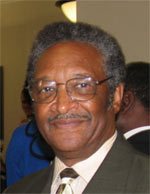Building at FAMU named for former COE professor
He worked on the NASA’s mission to the moon, helped implement the Civil Rights Act and served as a monitor for one of South Africa’s first post-apartheid elections. Now former COE professor Walter L. Smith has received one of the highest honors a university can bestow.

Smith
In a recent ceremony, Florida A & M University renamed its architecture building after Smith, who served as the university’s president from 1977 to 1985.
“This was more than just a building being named,” Smith said. “For me, this was part of a family legacy.”
Smith’s family ties to FAMU go back to the 1930s, when his grandfather worked as a caretaker on the research farms operated on campus. Smith developed an intimate knowledge of the campus through his grandfather.
“As a boy, I would ride on my grandfather’s wagon as he made his rounds,” Smith said. “I walked the university grounds as a boy and got to know the place well.”
Smith’s mother also attended FAMU, where she learned to sew – later becoming a successful and well-known clothing designer in the Tampa area.
Smith began his own educational career at the now-defunct Gibbs Junior College, an all-black community college in St. Petersburg. He went on to receive a bachelor’s degree from FAMU and a doctorate from Florida State.
In the years immediately following the passage of the Civil Rights Act, Smith worked for the federal government, helping develop the Titles IV and VI programs for school desegregation. He also worked at Kennedy Space Center, developing a technical education curriculum for engineering assistants on the Saturn V program.
Smith went on to become provost of Hillsborough Community College, president of Roxbury Community College in Massachusetts before being named president of FAMU. After leaving FAMU, he became a senior Fulbright scholar to the University of Malawi.
At FAMU, Smith was best known for expanding the college’s programs and establishing the university’s first doctoral program. He also went to bat for various on-campus construction projects, at a time when Board of Regents was reluctant to fund new facilities at FAMU.
“I went over their heads,” he said. “I went to the Governor and the Legislature, and had some success.”
Smith says his push for new campus facilities in the 1980s was probably the reason FAMU’s architecture faculty requested their building be named in his honor.
After leaving the presidency of FAMU, Smith traveled to post-apartheid South Africa to help that nation establish a community college system. That project was ongoing in 1995, when he joined the faculty of UF’s Educational Leadership and Policy department.
At UF, Smith’s community college expertise provided a valuable contribution the Institute of Higher Education. Among his well-known publications is the book The Magnificent Twelve: Florida’s Black Junior Colleges. The book tells the story of Gibbs Junior College and the state’s other segregation-era black two-year colleges, which served as building blocks for Florida’s current community college system.
Smith retired from UF in 2000, and now lives in Tampa, where he bought a building in his old neighborhood and turned it into a library for neighborhood children.




